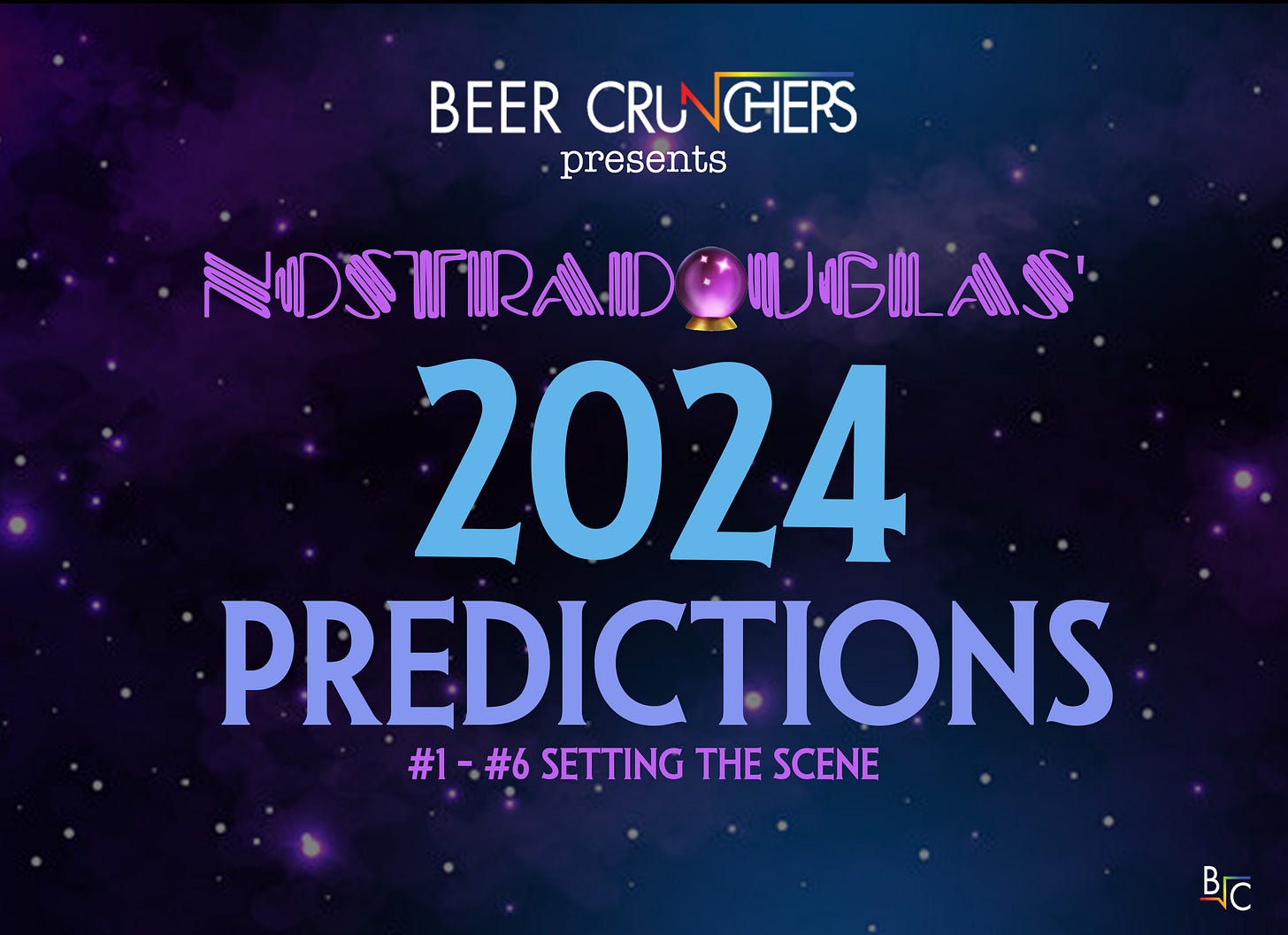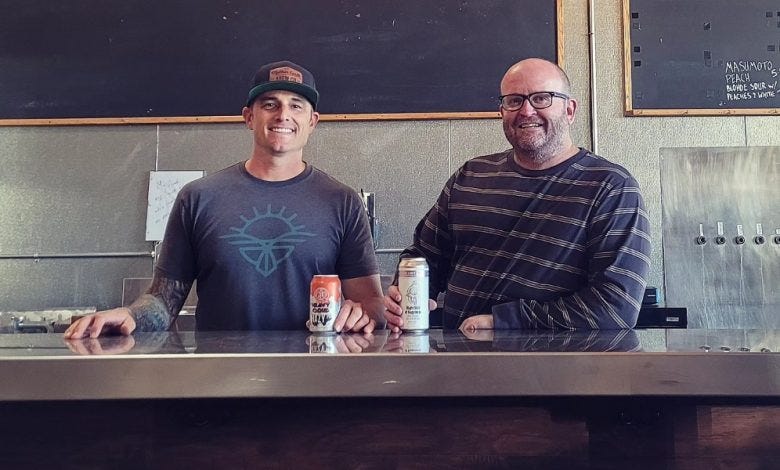Welcome to a special guest post where we’re lucky enough to be joined by Nostradouglas, Doug’s alter ego and the beer industry’s top soothsayer. Nostradouglas didn’t travel all the way from next December to tell you that a bunch of breweries are going to close in 2024. He knows that you already know that, nor will he waste your time sharing that THC beverages are the next hot topic in the industry. Those dominoes are already beginning to fall. Instead, let’s gaze deep into the cosmos and discuss the less-talked-about visions on Nostradouglas’ mind 🔮
1. Brand Contusion 🚑
It’s not uncommon for a brewery to struggle to the point that it can no longer sustain the operation it’s built. In some cases, their brands and recipes still have value thanks to a built-in customer base, albeit a shrinking one. This is in part why 1) California’s Bear Republic folded into Drake’s Brewing, 2) Milwaukee Brewing’s brands were picked up by Eagle Park after selling their production facility to Chicago’s Pilot Project, and 3) Anchor Brewing shut down, but will likely be reintroduced once it’s IP is auctioned off to a new buyer. There are moves like these happening all around the country because the brand acquisition represents established volume for a brewery that could use it.
It’s unlikely however that marketing teams and budgets are being scaled proportionately to support these new breweries-turned-brands. If marketing’s attention and resources are being stretched and there’s no longer an actual brewery location to experience, Nostradouglas struggles to find many of these acquisitions that don’t continue getting smaller as their cultural relevance fades. That doesn’t make them bad purchases, depending on the price, it just makes it hard to imagine a turn around in momentum. There’s a path to being wrong with this prediction, but that would require funds and share of mind being allocated to these acquisitions beyond what may be realistic in most cases.
There’s other ways that alliances will formed as well, including…
2. Shared Infrastructure & Taproom 🤝
In Chicago, we have an interesting concept called District Brewyards which has a square-shaped Taproom near downtown, with four unique breweries each having their own dedicated side of the room and taps. Each beer is contract brewed by DBY, so this shared Taproom presence falls into their offerings when a brewery partners up with them. Patrons are able to go back and forth, trying beers from any of the four, mixing and matching as they please. The unique model worked well enough that they opened a second one in late 2022 in Wheeling, IL.
Similar but different, San Diego Beer News recently shared that Mother Earth Brewing and the Lost Abbey, who had recently teamed up to share production space, were working toward opening a shared Taproom of their own. Fans of both breweries will now have twice the incentive to stop by with 32 taps to choose from, split between the two companies. The Lost Abbey recently divesting their IPA-heavy Port Brewing portfolio and The Hop Concept brands to Pizza Port in an effort to slim down and focus on their Belgian-inspired, funky, and barrel-aged roots. Pairing up with Mother Earth whose year-round offerings include a line of Cream Ales, IPAs, and a Milk Stout makes the two compliment each other well. Nostradouglas expects to see more examples of this sharing of infrastructure and resources between two or more beloved local breweries who may be stuck at an awkward size.
3. Accepting Being #2 🥈
Not to the level of Treehouse Brewing buying a golf course, or Other Half opening a Taproom in a new Chicago concert venue, but Nostradouglas looks forward to craft brewery strategies in 2024 that rely less on the beer itself to serve as the primary draw for new customers. Nostradouglas believes that the key to growth as craft beer matures is to find new ways for the beer to take on the supporting actor role.
To provide a personal, outside-the-box example, one of our biggest on-site wins has been “Language Cafe.” Special nights in our Taproom each month have each table marked with a unique language from around the world. Large crowds show up and each individual sits at the table of a particular language they speak to meet other locals who likely share that in common and now have an easy ice breaker to begin a conversation and network. In this example, attendees are excited to have a few beers, but it’s the “Language Cafe” that’s the real draw. Here’s a clip from NBC’s Chicago Today about it:
4. The 12oz Pour
While on the topic of drawing beer fans back to brewery taprooms, a cheap pour option has the opportunity to attract the many critics of craft beer pricing. Putting the beer into a 12oz glass size provides the opportunity to get the price even lower, while increasing the odds of a 2nd (or 3rd). There’s a lot of fun, unique glassware out there that can provide the beer an iconic look and feature the brewery’s most economically priced year-round option. Naperville’s Solemn Oath Brewing was early to this idea, launching their Logan Square city location in 2021 with 12oz “bow tie” glasses of their Kölsch Lü. While on the topic of broadening craft beer’s audience…

5. C̶r̶a̶f̶t̶ Brewery
Four years ago, as the Hard Seltzer phenomenon got hot, big breweries saw the writing on the wall early. Press releases were issued and media conversations occurred announcing the company name changes to now end in “Beverage Company” going forward, instead of “Brewing Company”. Those companies which include Molson Coors stuck to those plans investing in countless “beyond beer” brands including those backed by celebrities and in partnership with non-alc companies like Topo Chico, Mt. Dew, Dwayne “The Rock” Johnson, Travis Scott, and every Orange Juice label in existence.
Similar, but different, Nostradouglas sees 2024 as the beginning of craft breweries preferring to think of themselves simply as a brewery. The perceived meaning “craft” has slowly deteriorated as it used to go hand-in-hand with being “independent”. Over the last ten years, acquisitions saw craft breweries fall into the hands of macro breweries, who still use the term craft freely. And whose to stop them? The name sounds like it should be connected to ingredients or process, but it’s instead tied to ownership and size by the Brewers Association, and perhaps big flavor and alcohol by casual beer fans.
While there’s still a healthy base of consumers who love 'craft beer and associate their passion with that term, Nostradouglas pontificates that it’s stigma could actually stall the future growth that 9,000+ breweries will need if they’re going to survive. But where is that growth going to come from? I’ve got one crazy idea that ties in perfectly and I can’t believe I’m saying this…
6. The Year of the Lager (Seriously This Time!)
Nobody has made fun of the “Year of the Lager” more than Nostradouglas over the years. It was deserving of jabs at its inception in 2014, when those citing it’s pending rise were using IPA as the benchmark to surpass. “Craft” Lager was never going to surpass IPA at it’s price point, nor is it going to in 2024. That being said, lager is having a long, drawn-out moment for a few years now that seems poised to break out. In a sea of red, take look at a few of the bright spots:
We’re being told that consumers are drinking less, but as a result, are willing to spend up for higher price points. Makes sense to me and if that notion proves true, then lagers from craft breweries could be well-positioned if, and this is a big IF, they can get their message across. One of the countless challenges with building a new lager brand lies in sampling. A traditional craft beer festival with 1-2oz sample pours isn’t how you introduce someone to their new fridge staple. They need the entire glass, can or bottle, ideally paired with a good time like a sporting event, concert, street fest, or just being handed one at a party. Those types of opportunities tend to require bigger investments and therefore, a more all-in approach.
In 2024, Nostradouglas is valuing the on-site experience at the brewery more than ever, paired with unique draws that can bring new faces in. Without a physical taproom, the ability to create relationships with new customers is extra challenging. Unique partnerships give prospective fans 2x the reasons to show up, which can exponentially increase interest. Add focus to an approachable style like American Lager or Pilsner, perhaps in an affordable 12oz size, and you’ve lowered a draw bridge into c̶r̶a̶f̶t̶ beer 🔮









I'm pretty curious about the logistics of a shared taproom space - financing, staffing, marketing. I love the idea as a consumer, and as a brewery it could be an excellent way to break into a new market (team up with an established brand). Curious how this works on the business side, though.